On March 3, 2023, Garden Spot Fire Rescue in Lancaster County, Pennsylvania, and mutual-aid departments were dispatched for a reported structure fire at a utility building on an agricultural property. Although not uncommon for this rural area of Lancaster County, the rapidly deteriorating conditions indicated otherwise. The first-arriving unit was an engine company reporting smoke showing from all sides. As crews initiated their fire attack, they soon learned that the contents were lithium ion (li-ion) batteries, which thus changed the incident’s dynamics, strategies, and tactics and required the assistance of numerous special agencies and community resources.
- The Lithium-Ion Revolution
- Lithium-Ion Batteries: The 18650
- Humpday Hangout: Lithium-Ion Battery Fires
The Structure
The one-story, 40- × 80-foot building featured wood-frame construction with metal walls and roof. Fortunately, it was positioned along the roadway at the front of the parcel, which aided accessibility. Side A faced the road (photo 1). It was primarily used for farm equipment storage, but the owner had sublet a 25-percent portion of the overall footprint at side A/D to a vendor of li-ion batteries. Neither the fire department nor the local municipality was aware of this prior to the fire.

(1) An aerial view of the fire building (circle).
Source: Imagery © Maxar Technology, PA Department of Conservation and Natural Resources-PAMAP/USGS, U.S. Geological Survey, USDA/FPAC/GEO, Map data 2023.
The area is in rural eastern Lancaster County, southeast of the borough of New Holland, protected by Garden Spot Fire Rescue (GSFR), an all-volunteer fire department operating three stations. Station 3 was only one mile from the fire location.
Initial Response
At 1719 hours, the first-alarm building fire assignment comprised of four engines, two trucks, three rescues, and three tankers (tenders) was dispatched. The initial 911 call reported a two-story building with smoke coming from it. A note in the computer-aided dispatch reported that no hazardous materials were present. A second 911 call reported an equipment shed on fire.
GSFR Engine 39-3 was the first-arriving fire unit at 1724 hours and reported smoke showing from all sides. Fifteen seconds later, the GSFR duty officer arrived, reported a light smoke condition (photo 2), and assumed incident command. Crews initiated their structure fire standard operating procedure, which included advancing handlines and establishing a water supply.
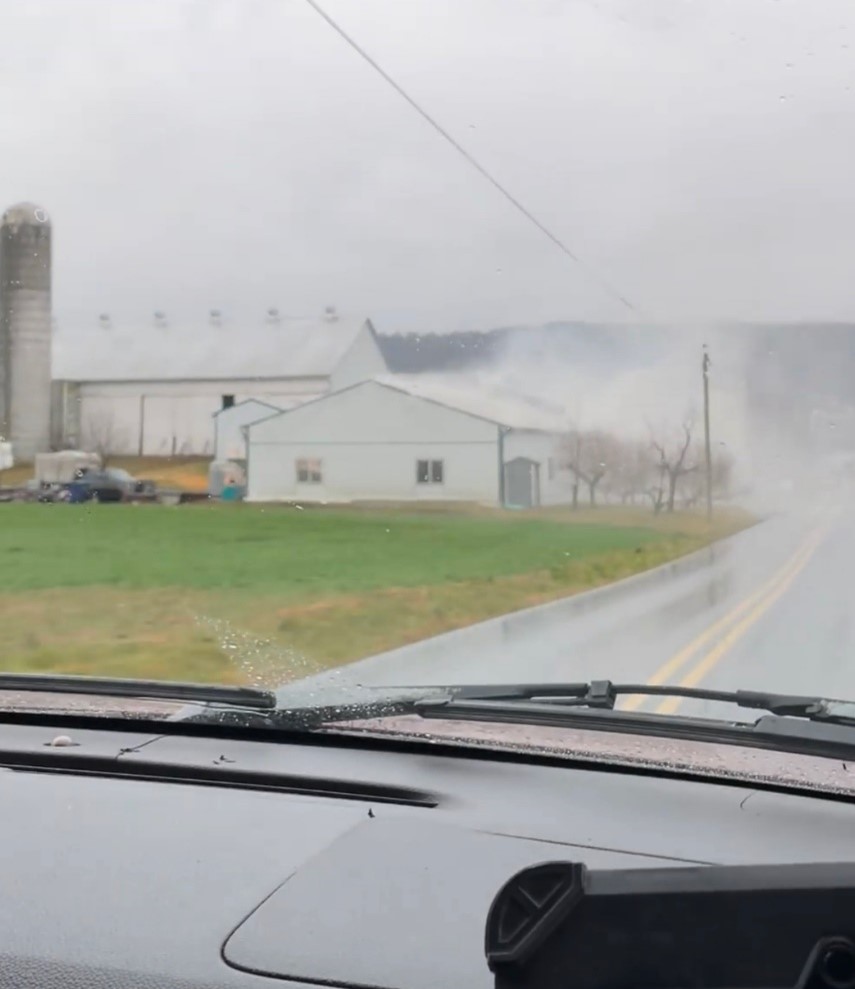
(2) Conditions on arrival of the fire department duty officer. (Photo by Stefan Kuenzli; photos courtesy of Garden Spot Fire Rescue unless otherwise noted.)
The water supply plan was to draft from a pond 600 feet away in a meadow. After an engine company cut through a fence to access the pond, fainting goats in the meadow prevented apparatus from accessing the pond. This dilemma caused the incident commander (IC) to request six additional tankers (tenders).
Changing Conditions
The first attack crew entered a man-door on side C (at the corner of side D) that led to a small makeshift service area. Another crew went to the roof to ventilate. Other garage type doors on side C were opened.
At 1733 hours, conditions rapidly deteriorated. With the help of 13-mile-per-hour sustained winds with higher gusts, fire broke through the roof at the A/D corner. High-velocity, voluminous smoke (photo 3) emanated from the opened doors and eaves (photo 4), prompting the IC to order crews to evacuate from the roof.
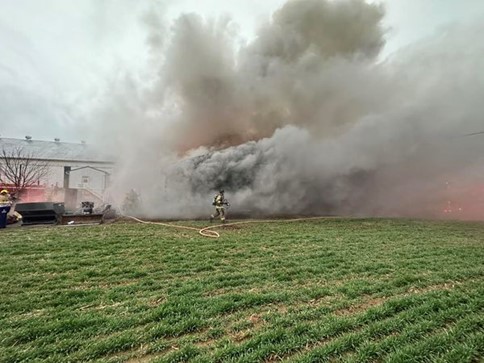
(3) Conditions shortly after arrival on side B.

(4) Conditions on side B at the side C corner.
Technical Specialists
Interior crews soon recognized that li-ion batteries were involved. At 1747 hours, the IC requested notification of the county hazardous material duty officer (HMDO). The HMDO discussed the immediate hazards with the potential for hydrogen fluoride (HF) gas and hydrofluoric acid to form with the application of water. The HMDO responded to monitor the scene. Trace amounts of HF were detected in the immediate area of the building.
The quantity of batteries was not immediately known. The battery distributor arrived on scene about a half hour into the incident and could not provide an inventory to the IC. However, it was learned that there was a shelving arrangement comprised of a steel framing system with three tiers of shelves. The arrangement essentially formed a U shape around the interior walls of sides D and A and along an interior wood frame partition wall that separated the battery vendor from the equipment storage area.
Strategies/Tactics
The incident action plan (IAP) was modified to limit the use of water to prevent the production and runoff of hydrofluoric acid by removing the batteries and placing them in containers. Hazmat 2 Environmental Fire & Rescue Company (HM2), the county hazmat team, requested mutual aid from the Lebanon County (PA) hazmat team for extra containment barrels. HM2 had two open-top 55-gallon metal drums; Lebanon County had eight.
Because of the HF potential and the trace amounts detected, crews working in the immediate area, even if not in a smoke-affected area, were directed to don self-contained breathing apparatus (SCBA) (photo 5). This continued through overhaul (photos 6-7). A firefighter wearing SCBA used an on-site skid loader to remove burning battery materials from the building and placed them in the containment barrels.
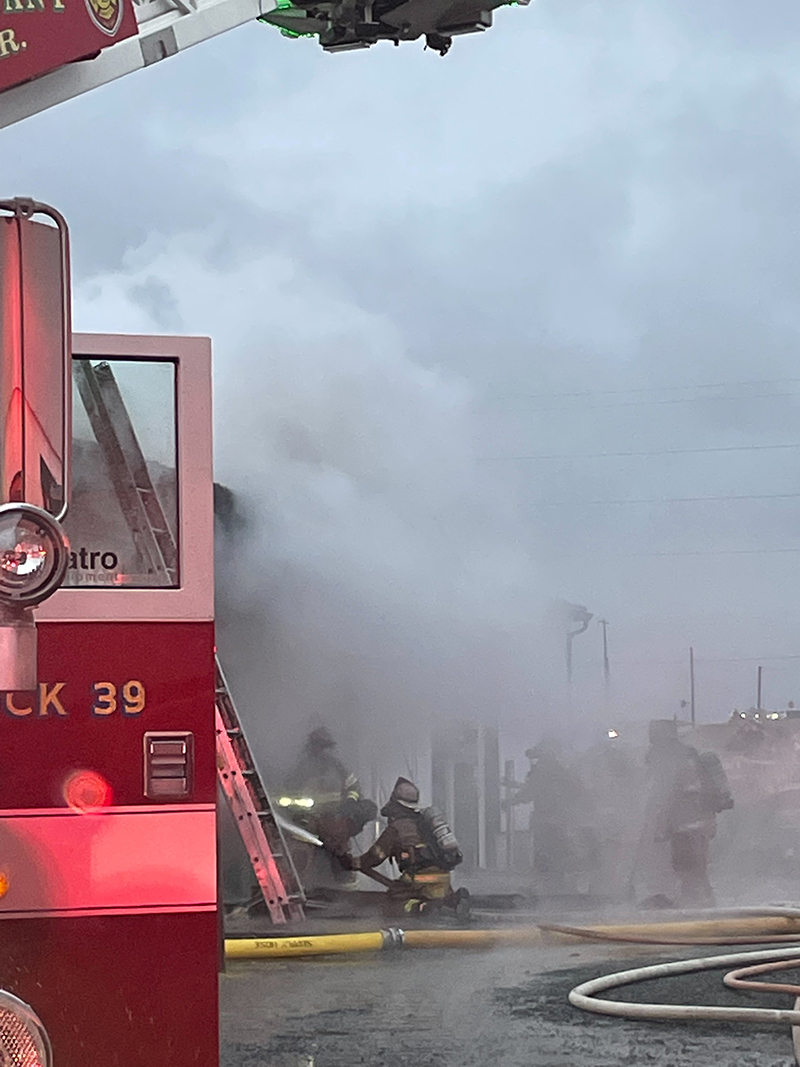
(5) Side D at the side C corner at the height of firefighting operations.
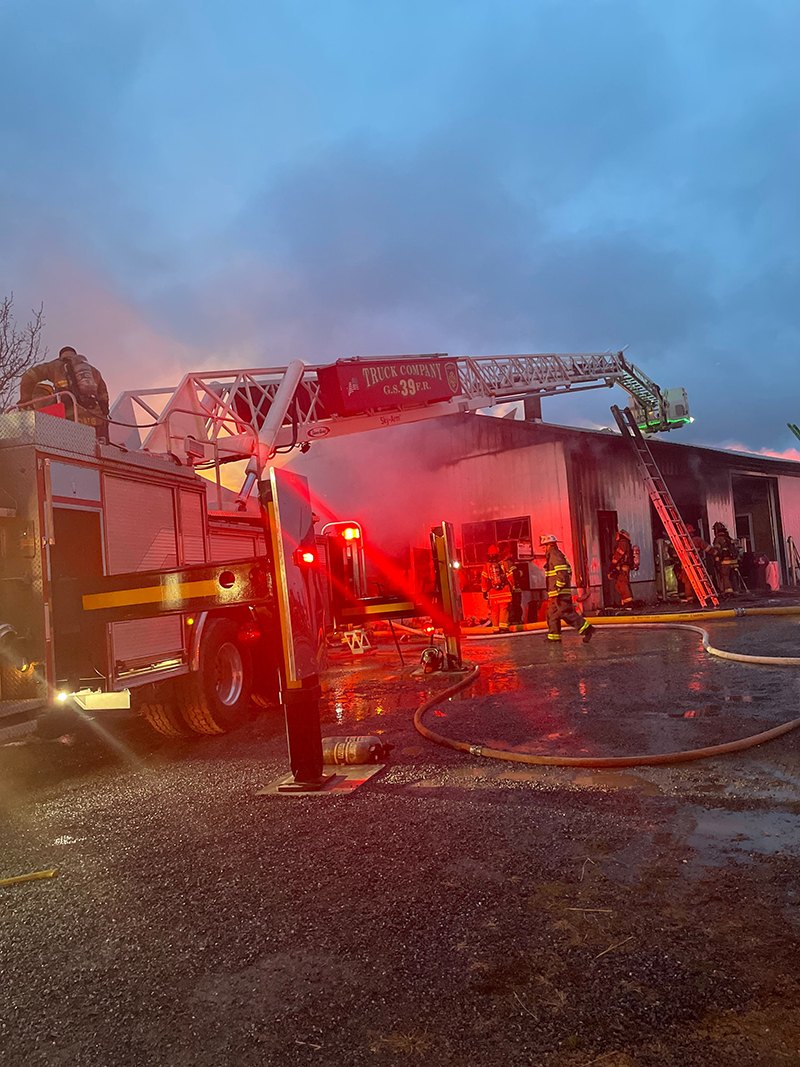
(6) Side D at the side C corner during overhaul.

(7) Side D at the side A corner during overhaul operations.
Resource Management
Additional recon found that there were nearly 30 pallets filled with li-ion battery packs used for mobility equipment, power tools, and consumer devices stored on three tiers of shelves and on plastic pallets on the floor that would need to be removed. At least half of the pallets were involved in fire; others had melted down and fused products together, making it impossible to separate the pallet from the products. It greatly exceeded the capacity of the 10 55-gallon, open-top metal drums available.
A local disposal company was contacted and brought out a 20-yard dumpster that was quickly filled (photo 8). A second disposal company was contacted and delivered two dumpsters with 30-yard and 40-yard capacities.
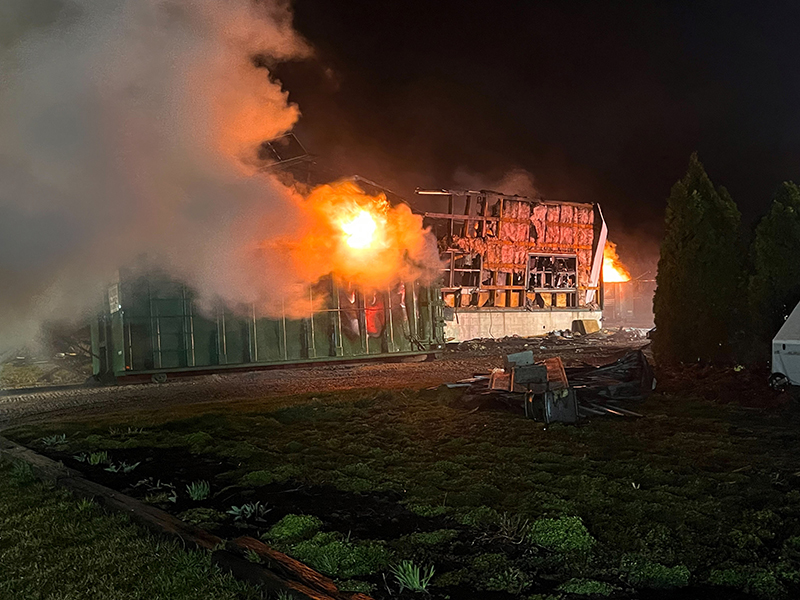
(8) The initial dumpster placement by side D allowed heavy equipment to fill the dumpsters.
The collapse of the roof and shelving systems was anticipated, and the use of the skid loader was discontinued. A local mulch company was contacted to bring in a track hoe with a grabber device to initially dismantle the roof system. The track hoe operator was equipped with SCBA and made quick work of the roof system. The track hoe operator continued to fill the dumpsters with battery debris, which became well-involved in fire. A blanket of non-per- and poly-fluoroalkyl substances, aqueous film-forming foam was applied to the dumpsters to darken down the fire so that the containers could be relocated across the street in a field to allow them to free burn (photo 9).

(9) Heavy equipment transferred the dumpsters across the road to a field to allow the fire to burn itself out.
Liaison Agencies
Fire department operations ceased at 0213 hours the next morning. Because of the nature of the event, the Pennsylvania Department of Environmental Protection sent a representative that night to assist with monitoring in conjunction with the hazmat team and to follow up on disposal. The Occupational Safety and Health Administration arrived the day after. Regarding the investigation into the origin and cause, it is undetermined.
Lessons Learned/Reinforced
Although in such incidents “what went wrong” elements are mentioned, “what went right” aspects are important too. This unique incident exhibited many examples of both pre- and post-dispatch response preparedness and discipline that limited the adverse effects.
Situational awareness. Rapidly changing conditions warranted changing the IAP based on the risk/benefit matrix. Going from a low-frequency/low-risk incident (an agricultural utility building fire) to a low-frequency/high-risk event (a fire involving by-products of li-ion batteries and chemical reactions with the addition of water) heightened personnel safety concerns and avoiding environmental contamination.
Interagency preincident coordination. This incident reinforced the benefits of interagency preincident coordination and establishing relationships with cooperating agencies. The relationship between GSFR and its close-knit community partners allowed seamlessly procuring atypical resources that fostered timely mitigation. Preresponse coordination enabled stakeholders to understand their roles, responsibilities, capabilities, and action expectations. A consortium of area fire companies including GSFR has routinely collaborated with the mulch company used at this incident previously to the point that the consortium purchased and issued firefighting turnout gear to the mulch company to protect its employees while assisting with overhaul at fire scenes.
Training. GSFR has engaged in electric vehicle response training for which basic concepts correlated to this incident. As illustrated for this incident, the relatively quick realization that li-ion batteries were involved and the subsequent adverse ramifications of enlisting typical firefighting strategies aided in modifying the IAP to avert a cascading event.
Reading smoke. This is a critical continuous size-up skill. The light color of the smoke initially indicated an incipient developing fire. However, the rapid change, not so much in smoke color but in velocity and volume, indicated that this was not a typical agricultural contents fire.
Personal protective equipment. This is a must for all firefighting personnel, including SCBA. When the fire broke through the roof, a pumper-tanker operating on side A was enveloped in smoke. The fire apparatus operator was able to blindly crawl in the fire apparatus and find an SCBA at an unoccupied seat and had to abandon the unit for a short time to don the SCBA in tenable conditions.
Conducting preincident intelligence. It is imperative to gather intelligence on all your protected elements, not just the stereotypical target hazards. The level of hazard within a community is not based only on its urban, suburban, or rural disposition but on the fire department’s preincident recognition, preparedness, and countermeasure efforts. “A chain is only as strong as its weakest link” applies to preincident preparedness. The fire department’s effectiveness is only as strong as the element it is not prepared to respond to.
Murphy’s Law. Remember, no matter how well you prepare for an emergency, Murphy’s Law is always lying in wait. Water supply Plan A for this event was establishing a draft at a nearby pond. Plan B, however, was necessary to implement because fainting goats blocked access to the pond after the fire apparatus entered the meadow.
Hazmat. Another lesson is the need to redefine hazmat in the context of 911 call taking. The 911 callers did not indicate li-ion batteries were involved and likely did not know. However, for future reports, the public safety answering points should inquire as to the presence of li-ion batteries and other hazards.
Match the tactic to the hazard. The fire service mainstay, “Put the wet stuff on the red stuff,” is not applicable in all circumstances. We need to reevaluate the suitability of this tactic at all incidents, especially given the increased use and presence of li-ion batteries. The IC estimated that between 8,000 and 10,000 gallons of water were used at this fire. After the IAP was modified to remove the batteries with heavy equipment into the dumpsters, water was used sparingly only to darken down the materials that were on fire that the track hoe grabber was removing to place in the dumpsters.
For some areas, like New York City, li-ion emergencies have become commonplace. If you haven’t responded to such an emergency yet, just wait, you will. This expanding technology and its ever-increasing and ubiquitous use are rapidly exceeding fire service training, research and development, and best practices.
The textbook answers to responding to li-ion emergencies haven’t been written, so most agencies will learn through trial and error. Since the battery technology is evolving and applications for them are infinite, books written about them today will surely be obsolete after they are published.
Soon li-ions will be part of our daily lives at home, in transportation, and in business. The fire service must continuously study this and similar incidents. The United States Department of Transportation Pipeline and Hazardous Materials Safety Administration, the National Transportation Safety Board, Underwriters Laboratories, and the International Association of Fire Chiefs, among others, have published guidance documents to study. This hazard and others command your attention to preparedness.
Eric G. Bachman, CFPS, AEM, is a 40-year veteran of the fire service and fire marshal for Manheim Township Fire Rescue in Lancaster, Pennsylvania. He retired as the hazardous materials administrator for the Lancaster County Emergency Management Agency after 31 years of service. He is a volunteer firefighter with the West Hempfield Fire & Rescue Company.

